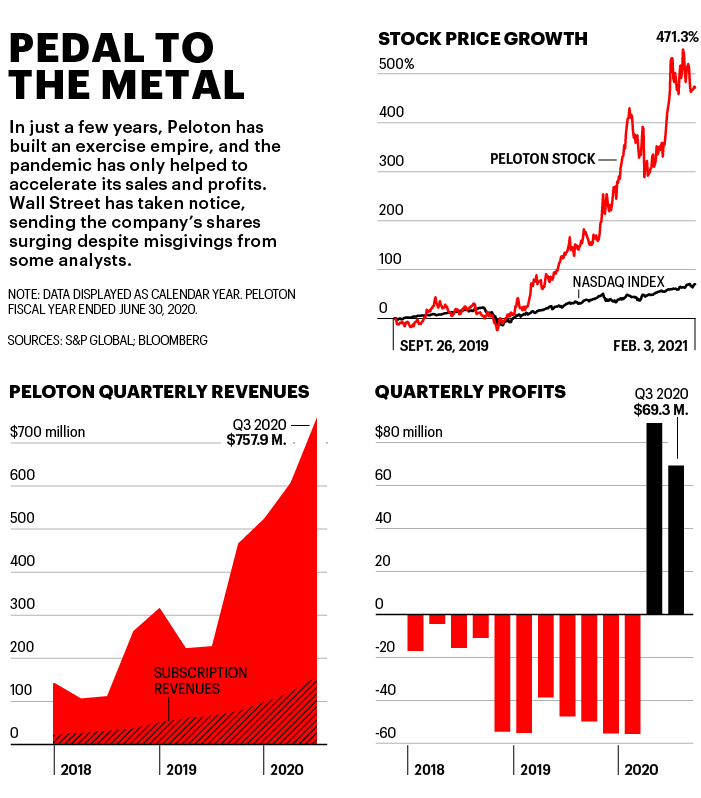Table of Contents
- About Peloton
- The Peloton Ecosystem
- Fitness Gamification
- Gamifying Fitness: The Leaderboards
- Conclusion
Although COVID-19 is undoubtedly a global crisis but it can be attributed to the acceleration of the digital transformation of our world for several years in just a few months. We have seen significant growth in areas such as online grocery shopping, video calling and streaming services from Zoom, Doordash, Walmart.com, Amazon, Netflix, Etsy and many more.
Peloton is an American fitness equipment and media company headquartered in New York City. It was founded by John Foley in 2012 and launched in 2013 with the help of a Kickstarter funded event.

There is no doubt that Peloton had record sales for any startup. They are valued at over 4 billion U.S. dollars and may conduct an initial public offering early next year. A bike costs more than $2,000 which is higher priced than the average fitness bike. But this did not deter people since they have sold more than 300,000 fitness bikes.
- Peloton has more than 4.4 million members on the platform
- 1.67 million people have subscribed to Peloton’s connected fitness members
- Peloton has more than 625,000 pure digital paying users
- Peloton has a large touch screen on the front which is used to transmit live lessons to the bicycle
- 98.07 million workouts are completed quarterly on Peloton
- Peloton’s quarterly revenue is $1.06 billion
- Peloton has 35 instructors

The Peloton Ecosystem- Bike hardware, Media library, Connected fitness, Live instructors, Gamification
- Bike hardware
- Media library
- Connected fitness
- Live instructors
- Gamification
Peloton is more than just a bike. This is a complete ecosystem, and its experiences complement each other.
The core products of this ecosystem are Bike, hardware, Connected Fitness, live instructors and Gamification. Peloton Digital is an app that allows access to Peloton’s home fitness, health, and wellness content suite.
Bike Hardware
Bike hardware provides invaluable data to help Peloton understand how to provide its members with a consistently better experience.
Media Library
The basis of Bike, Tread and Digital is Peloton’s digital media library. As mentioned earlier, one of the most important factors that distinguish Peloton from its competitors is the quality of the courses it offers.
The course library adds value to the hardware to create more attractive exercises.
Peloton has engaged with the celebrities and influncers that has created a fitness empire.

Fitness Gamification
The peloton makes fitness fun, approachable, effective and convenient while promoting social connections and encouraging its members to be their best selves.
In recent years, we have seen many technologies (including gamification) incorporated into fitness habits, ultimately allowing us to stay motivated and engaged.
Take Peloton as a good example; they use technology to bring group exercises into people’s homes and stream the entire bike exercise with social platforms to keep users engaged.
- Gamification of exercise can help members get the most from their daily activities, and technology can help achieve this goal
- Technology allows people to track their performance to see how they are, or whether they are improving every week, which can motivate people to improve
- Another such area is the fitness market. With the closure of national and global gyms, people are always looking for alternative ways to stay healthy at home. Therefore, few companies can see a strong tailwind like the companies behind Peloton Interactive
- One of the most important parts of Peloton’s business for pioneering digital fitness is its media products. Its media experience is one of the main reasons customers choose Peloton over its competitors
- Media companies monetize time and attention by providing certain content to consume. With this broad definition, even though the New York Times and Xbox are not generally considered similar, media companies with significantly different content types are grouped
- To understand this category more clearly, we can consider the purpose of the content. Companies such as Wikipedia, Google, and Yelp provide useful information, a kind of utility. Other companies such as Disney and TikTok provide entertainment services
- The third option is somewhere in between a mix of utility and entertaining-such as TED talks, travel blogs or business books
- Peloton belongs to the third category, seeking to provide fitness, health and wellness effects and a highly entertaining exercise experience. What enables Peloton to successfully deliver is not just any product, but a strong ecosystem.

The Community
Working together is fun, but because the bike is in your home, Peloton has to be creative in how to develop the community. To do so, Peloton allows you to:
- Follow the leaderboards of the live or on-demand courses you are attending.
- Use tags to develop your digital identity and connect with others in the community.
- Encourage other members with the number “high five”.
- Follow friends.
- Video chat and
- Join the official Peloton member Facebook page to receive updates and contact.
Community is a way that Peloton can play a role in its members’ lives without using Digital, Bike, and Tread for 23 hours a day, thereby transforming the company’s products from an experience to a lifestyle.
For example, in the official Facebook group, there are subgroups such as the official Peloton Mom group, Peloton working mom, Peloton Moms Who Shop, and Peloton Moms Book Club. Peloton is more than a one-off experience; it provides value around the clock.
Gamifying Fitness: The Leaderboards
There are many interesting things to talk about here but the one feature that I am fascinated by is the leaderboard. The leaderboard allows you to know in real time your best performance relative to other people (people who have taken the course) and your personal best. This view can also be filtered by gender and age category.
Subscription-based Ecommerce
Peloton requires a monthly membership fee of $39 to access the courses and additional features of its fitness equipment or users who only access content through apps or websites need to pay a membership fee of $12.99.
The strong ecosystem of Peloton has enhanced its brand and customer stickiness, and the company has already reaped some rewards. However, as mentioned above, the competition is fierce, and they are arming themselves in recognition of the rise of Peloton.
For Peloton, there is no time to celebrate, otherwise, its leadership may be short-lived. It must continue to develop, innovate, and provide its members with extraordinary health and wellness experiences.
Conclusion
Peloton’s business model has achieved great success by defining a new category, vertical integration and creating an ecosystem that is difficult to compete. However, the company has proven that there are significant opportunities in the connected fitness market, and as a result, competitors are vying to get a share of the pie.
To stay ahead and win in the connected fitness market, Peloton needs to strengthen its value proposition and deepen its moat through health analysis to showcase results and a sports community so that members never want to leave the world of Peloton.
Deepak Wadhwani has over 20 years experience in software/wireless technologies. He has worked with Fortune 500 companies including Intuit, ESRI, Qualcomm, Sprint, Verizon, Vodafone, Nortel, Microsoft and Oracle in over 60 countries. Deepak has worked on Internet marketing projects in San Diego, Los Angeles, Orange Country, Denver, Nashville, Kansas City, New York, San Francisco and Huntsville. Deepak has been a founder of technology Startups for one of the first Cityguides, yellow pages online and web based enterprise solutions. He is an internet marketing and technology expert & co-founder for a San Diego Internet marketing company.



